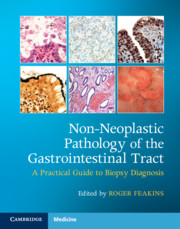Book contents
- Non-Neoplastic Pathology of the Gastrointestinal Tract
- Non-Neoplastic Pathology of the Gastrointestinal Tract
- Copyright page
- Dedication
- Contents
- Preface
- Acknowledgements
- Contributors
- Chapter 1 The Value of Gastrointestinal Biopsy
- Chapter 2 Gastrointestinal Involvement by Systemic Disease
- Chapter 3 Radiation and the Gastrointestinal Tract
- Chapter 4 Transplantation, Immunodeficiency, and Immunosuppression
- Chapter 5 Drug-Induced Gastrointestinal Disease
- Chapter 6 Gastrointestinal Ischemia and Vascular Disorders
- Chapter 7 Paediatric Conditions
- Chapter 8 Gastrointestinal Dysplasia
- Chapter 9 Normal Oesophageal, Gastric and Duodenal Mucosa
- Chapter 10 Histology of Gastroesophageal Reflux Disease and Barrett’s Oesophagus
- Chapter 11 Infections of the Oesophagus and Rare Forms of Oesophagitis
- Chapter 12 Assessment of Gastric Biopsies
- Chapter 13 Types of Gastritis
- Chapter 14 Duodenitis
- Chapter 15 Coeliac Disease
- Chapter 16 Inflammatory Bowel Disease and the Upper Gastrointestinal Tract
- Chapter 17 Normal Lower Gastrointestinal Mucosa
- Chapter 18 Infectious Disorders of the Lower Gastrointestinal Tract
- Chapter 19 Jejunitis and Ileitis
- Chapter 20 Microscopic Colitis
- Chapter 21 Inflammatory Bowel Disease Diagnosis
- Chapter 22 Mimics of Inflammatory Bowel Disease
- Chapter 23 Complications of Inflammatory Bowel Disease
- Chapter 24 Approach to Reporting Inflammatory Bowel Disease Biopsies
- Chapter 25 Ileal Pouch Anal Anastomosis
- Chapter 26 Diverticular Disease, Mucosal Prolapse, and Related Conditions
- Chapter 27 Non-Neoplastic Diseases of the Anal Canal
- Index
- References
Chapter 8 - Gastrointestinal Dysplasia
Published online by Cambridge University Press: 06 June 2020
- Non-Neoplastic Pathology of the Gastrointestinal Tract
- Non-Neoplastic Pathology of the Gastrointestinal Tract
- Copyright page
- Dedication
- Contents
- Preface
- Acknowledgements
- Contributors
- Chapter 1 The Value of Gastrointestinal Biopsy
- Chapter 2 Gastrointestinal Involvement by Systemic Disease
- Chapter 3 Radiation and the Gastrointestinal Tract
- Chapter 4 Transplantation, Immunodeficiency, and Immunosuppression
- Chapter 5 Drug-Induced Gastrointestinal Disease
- Chapter 6 Gastrointestinal Ischemia and Vascular Disorders
- Chapter 7 Paediatric Conditions
- Chapter 8 Gastrointestinal Dysplasia
- Chapter 9 Normal Oesophageal, Gastric and Duodenal Mucosa
- Chapter 10 Histology of Gastroesophageal Reflux Disease and Barrett’s Oesophagus
- Chapter 11 Infections of the Oesophagus and Rare Forms of Oesophagitis
- Chapter 12 Assessment of Gastric Biopsies
- Chapter 13 Types of Gastritis
- Chapter 14 Duodenitis
- Chapter 15 Coeliac Disease
- Chapter 16 Inflammatory Bowel Disease and the Upper Gastrointestinal Tract
- Chapter 17 Normal Lower Gastrointestinal Mucosa
- Chapter 18 Infectious Disorders of the Lower Gastrointestinal Tract
- Chapter 19 Jejunitis and Ileitis
- Chapter 20 Microscopic Colitis
- Chapter 21 Inflammatory Bowel Disease Diagnosis
- Chapter 22 Mimics of Inflammatory Bowel Disease
- Chapter 23 Complications of Inflammatory Bowel Disease
- Chapter 24 Approach to Reporting Inflammatory Bowel Disease Biopsies
- Chapter 25 Ileal Pouch Anal Anastomosis
- Chapter 26 Diverticular Disease, Mucosal Prolapse, and Related Conditions
- Chapter 27 Non-Neoplastic Diseases of the Anal Canal
- Index
- References
Summary
There are significant differences between paediatric and adult gastrointestinal (GI) disease, and even the normal GI histology shows some variation.Excess eosinophils in the gut can be present in food allergies (frequent in children) but also in eosinophilic gastroenteritis. Inflammatory bowel disease (IBD) has some distinctive features when it presents in children. Genetic factors may play a greater role in pathogenesis, and the combination of clinical and histological criteria required for diagnosing Crohn’s Disease or ulcerative colitis (UC) is different. Atypical UC patterns are more common and clinical presentation of Crohn’s disease can also be different; the frequency of granulomas in Crohn’s disease is significantly higher in children. Inflammatory Bowel Disease Unclassified (IBDU) has its highest frequency in younger patients, possibly because of atypical characteristics of paediatric UC. Monogenic forms of IBD-like colitis typically develop during infancy or early childhood, an can have features of Crohn’s disease, UC or IBD unclassified. Histology is often indistinguishable from conventional IBD.Necrotising enterocolitis (NEC) primarily affects the small intestine of premature infants, with haemorrhagic necrosis of the bowel wall.Fibrosing colonopathy has been reported in children exposed to high doses of pancreatic enzymes and is characterised by bowel wall thickening, submucosal fibrosis and chronic mucosal inflammation.
Keywords
- Type
- Chapter
- Information
- Non-Neoplastic Pathology of the Gastrointestinal TractA Practical Guide to Biopsy Diagnosis, pp. 116 - 130Publisher: Cambridge University PressPrint publication year: 2020



